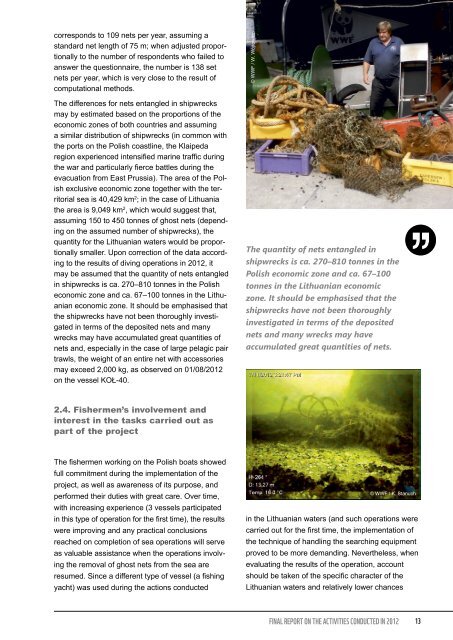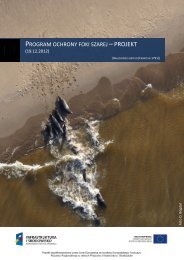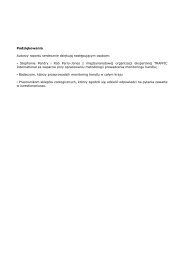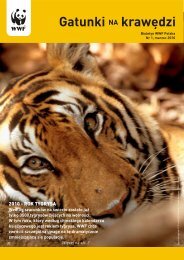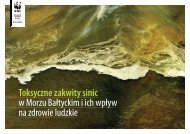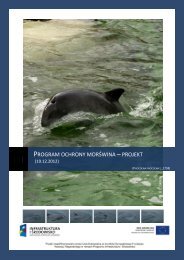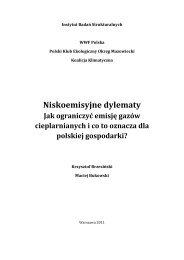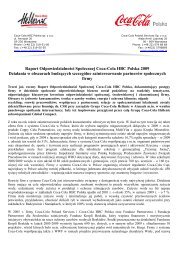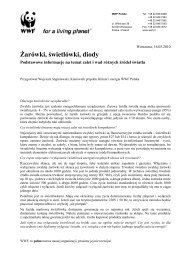COLLECTING GHOST NETS IN THE BALTIC SEA - WWF
COLLECTING GHOST NETS IN THE BALTIC SEA - WWF
COLLECTING GHOST NETS IN THE BALTIC SEA - WWF
You also want an ePaper? Increase the reach of your titles
YUMPU automatically turns print PDFs into web optimized ePapers that Google loves.
corresponds to 109 nets per year, assuming a<br />
standard net length of 75 m; when adjusted proportionally<br />
to the number of respondents who failed to<br />
answer the questionnaire, the number is 138 set<br />
nets per year, which is very close to the result of<br />
computational methods.<br />
The differences for nets entangled in shipwrecks<br />
may by estimated based on the proportions of the<br />
economic zones of both countries and assuming<br />
a similar distribution of shipwrecks (in common with<br />
the ports on the Polish coastline, the Klaipeda<br />
region experienced intensified marine traffic during<br />
the war and particularly fierce battles during the<br />
evacuation from East Prussia). The area of the Polish<br />
exclusive economic zone together with the territorial<br />
sea is 40,429 km 2 ; in the case of Lithuania<br />
the area is 9,049 km 2 , which would suggest that,<br />
assuming 150 to 450 tonnes of ghost nets (depending<br />
on the assumed number of shipwrecks), the<br />
quantity for the Lithuanian waters would be proportionally<br />
smaller. Upon correction of the data according<br />
to the results of diving operations in 2012, it<br />
may be assumed that the quantity of nets entangled<br />
in shipwrecks is ca. 270–810 tonnes in the Polish<br />
economic zone and ca. 67–100 tonnes in the Lithuanian<br />
economic zone. It should be emphasised that<br />
the shipwrecks have not been thoroughly investigated<br />
in terms of the deposited nets and many<br />
wrecks may have accumulated great quantities of<br />
nets and, especially in the case of large pelagic pair<br />
trawls, the weight of an entire net with accessories<br />
may exceed 2,000 kg, as observed on 01/08/2012<br />
on the vessel KOŁ-40.<br />
© <strong>WWF</strong> / W. Wójtowicz<br />
The quantity of nets entangled in<br />
shipwrecks is ca. 270–810 tonnes in the<br />
Polish economic zone and ca. 67–100<br />
tonnes in the Lithuanian economic<br />
zone. It should be emphasised that the<br />
shipwrecks have not been thoroughly<br />
investigated in terms of the deposited<br />
nets and many wrecks may have<br />
accumulated great quantities of nets.<br />
2.4. Fishermen’s involvement and<br />
interest in the tasks carried out as<br />
part of the project<br />
The fishermen working on the Polish boats showed<br />
full commitment during the implementation of the<br />
project, as well as awareness of its purpose, and<br />
performed their duties with great care. Over time,<br />
with increasing experience (3 vessels participated<br />
in this type of operation for the first time), the results<br />
were improving and any practical conclusions<br />
reached on completion of sea operations will serve<br />
as valuable assistance when the operations involving<br />
the removal of ghost nets from the sea are<br />
resumed. Since a different type of vessel (a fishing<br />
yacht) was used during the actions conducted<br />
© <strong>WWF</strong> / K. Stanuch<br />
in the Lithuanian waters (and such operations were<br />
carried out for the first time, the implementation of<br />
the technique of handling the searching equipment<br />
proved to be more demanding. Nevertheless, when<br />
evaluating the results of the operation, account<br />
should be taken of the specific character of the<br />
Lithuanian waters and relatively lower chances<br />
F<strong>IN</strong>AL REPORT ON <strong>THE</strong> ACTIVITIES CONDUCTED <strong>IN</strong> 2012<br />
13


